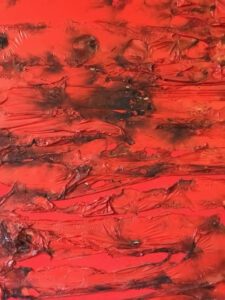Liviana Martin

Città di Castello, a town in the province of Perugia, has one of the largest collections of works by Alberto Burri (1915-1995). With its vast rooms, Palazzo Albizzini houses 129 works by this maestro of informal art and tireless experimenter who was capable of giving nobility and artistic form to the poorest materials. It was Burri himself who set up the Foundation in 1978 and displayed his works in this 15th-century Renaissance palace, which in its sobriety and architectural elegance makes his works stand out even more. In August 2020, with life in suspension due to Covid-19, I had the opportunity to visit the collection, fortunately open; it was a fascinating experience.
Burri, the one with the bags
During his long artistic career Burri used the most disparate materials, from jute bags to plastics, charred wood, iron and cellotex (a mixture of glue and sawdust used to insulate homes). For many years he was called the artist of the burlap bags, which when they were exhibited (around 1950) caused a real scandal. Burri repeated that the materials were of no importance, what mattered was the final result. Kafka said: “There is a destination but no way there; what we refer to as way is hesitation.”
His bags are torn, full of deep indents, enhanced by an unexpected red pigment, like a wound. A ‘classic’ interpretation of Burri links his choice of bags to his imprisonment in an internment camp in Texas during the Second World War. Burri also had a medical degree and the cuts, wounds and sutures relate to his profession as a surgeon. Burri, however, always rejected this interpretation of his work, which he considered too simplistic; his work had to have only an aesthetic value, without symbolic interference.
Fire painting
Even fire, which Burri used on his materials, was considered only a medium, like a brush, not a metaphor or a symbol. With fire he created Legni (Woods), or Combustions and I Ferri (Irons). Il Grande Ferro (The Great Iron, 1980) is a monolith similar to that in 2001-A Space Odyssey. Almost two meters tall, this black monochromatic Ferro (Iron) towers over us, bearer of ancestral messages. In his paintings, the irons seem to want to come out of the canvas, or the canvases are torn, making us think of Fontana’s cuts (he is said to be inspired by Burri). But there is also a reference to classical themes, as in Il Viaggio (The Journey, 1979), exhibited in the former Tobacco Drying Barns, another exhibition space of the collection, temporarily closed. The iron structure recalls the Madonna del Parto by Piero della Francesca, an artist whom Burri loved: instead of the figures of Mary and the two angels, who open a sort of curtain, there are iron sheets, but the design is the same.
Rembrandt’s drapery
Rembrandt’s A Woman Bathing in a Stream, who slowly raises her dress to enter the water, reminds us of the soft drapery that the plastic of Burri’s paintings creates, playing with light, forming holes which look like caves, encrustations, craters. The bright colors, red and black, recall Rembrandt, in particular his Slaughtered Ox. But above all beauty, hidden in any material, is revealed here in an exhilarating triumph of colors.
The Grande Cretto (The Great Crack) of Gibellina
The disastrous earthquake of 1968 in the Belice Valley in Sicily destroyed the town of Gibellina. In the new town, rebuilt a few kilometers away, the mayor invited several artists to give a message of rebirth and hope through their artwork. Among the artists who took part, Burri created a work on the rubble of the earthquake area, so that the memory would remain imperishable. The Grande Cretto (1985), with nine hectares of white concrete, is one of the greatest contemporary land art creations. It looks like a vast casting of concrete blocks, about 1.60 meters high, crossed by cracks of 2-3 meters wide that you can walk through, corresponding to the old streets of the ancient town. The idea is to keep alive the memory of Gibellina and the history of the town, even for those who never knew it.
The Cretti exhibited in Palazzo Albizzini, made up of clay, kaolin and other materials, are in black or white, conveying the idea of the force of nature, of its destructive but also regenerating energy.
“My last painting is the same as the first,” said Burri, to indicate how much all his works, regardless of the materials used, resembled each other in the formal search for absolute beauty and harmony.
Volume 35 no 2 November / December 2020

